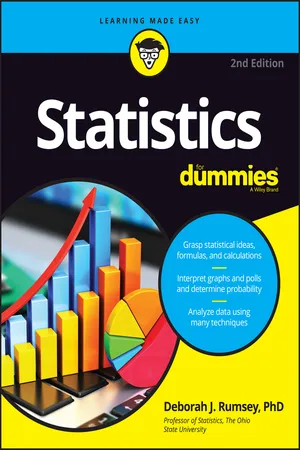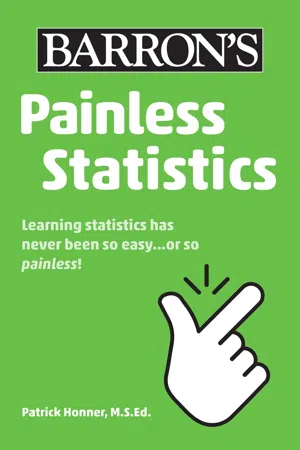Mathematics
Normal Distribution Percentile
The normal distribution percentile refers to the percentage of data points that fall below a particular value in a normal distribution curve. It is a measure of relative standing within the distribution, with the 50th percentile representing the median. This concept is widely used in statistics and probability to understand the distribution of data.
Written by Perlego with AI-assistance
Related key terms
Related key terms
1 of 4
Related key terms
1 of 3
11 Key excerpts on "Normal Distribution Percentile"
- eBook - ePub
- Deborah J. Rumsey(Author)
- 2016(Publication Date)
- For Dummies(Publisher)
X (a height, an IQ, a test score, and so on).Figuring out a percentile for a normal distribution
Certain percentiles are so popular that they have their own names and their own notation. The three “named” percentiles are Q 1 — the first quartile, or the 25th percentile; Q 2 — the 2nd quartile (also known as the median or the 50th percentile); and Q 3 — the 3rd quartile or the 75th percentile. (See Chapter 5 for more information on quartiles.)Here are the steps for finding any percentile for a normal distribution X:1a. If you’re given the probability (percent) less than x and you need to find x , you translate this as: Find a where p (X < a ) = p (and p is the given probability). That is, find the p th percentile for X . Go to Step 2.1b. If you’re given the probability (percent) greater than x and you need to find x, you translate this as: Find b where p (X > b ) = p (and p is given). Rewrite this as a percentile (less-than) problem: Find b where p (X < b ) = 1 – p. This means find the (1 – p )th percentile for X.- Find the corresponding percentile for Z by looking in the body of the Z -table (in the appendix ) and finding the probability that is closest to p (from Step 1a) or 1 – p (from Step 1b). Find the row and column this probability is in (using the table backwards). This is the desired z -value.
- Change the z -value back into an x -value (original units) by using . You’ve (finally!) found the desired percentile for X.The formula in this step is just a rewriting of the z -formula, , so it’s solved for x .
Doing a low percentile problem
Look at the fish example used previously in “Finding Probabilities for a Normal Distribution ,” where the lengths (X - eBook - ePub
Interpreting Statistics for Beginners
A Guide for Behavioural and Social Scientists
- Vladimir Hedrih, Andjelka Hedrih(Authors)
- 2022(Publication Date)
- Routledge(Publisher)
Proportion – is the share of entities with a certain value i.e. that belong to a certain category in the total number of observed entities. Proportion is calculated by dividing the frequency of the category whose proportion we wish to calculate with the total number of entities in the sample (proportion = frequency/total number of entities in the sample). Proportions are on a scale from 0 to 1. If the proportion of a value is 0, that means that there are no entities with that value. If the proportion is 1, that means that all entities in the sample have that particular value, i.e. that the examined variable is a constant (and not a variable, because a variable requires that entities have different values, when all entities have the same value, we are dealing with a constant).- Percentage (%) – is a proportion multiplied by 100. It is the same as proportion just rescaled to a span between 0 and 100. Percentage is denoted with the sign %. Percentage is essentially the same type of statistic as the proportion indicating the relative share of a certain category or value in the total sample, only using a number range that might be more convenient for practical use and communication (small, often whole number, instead of decimals).
3.2 Percentiles and other quantiles
Sometimes there is a need to mark specific positions on a distribution of a non-nominal variable. This is most commonly done through the use of percentiles and percentile ranks.- Percentile represents a point on the distribution below or in line with which lie the values of a certain percentage of entities from the sample. In other words, it is a value of the variable that is higher or equal to a specific percentage of values of entities in the sample. A percentile is named based on the percentage of entities that have values lower than or equal to the value of that percentile. For example, 50th percentile is a value that is higher than or equal to values of exactly 50% of the sample on the given variable. 100th percentile is the highest value in the sample. 0 percentile is the lowest value in the sample. 20th percentile is the value below or in line with which lie the values of exactly 20% of entities in the sample (while 80% have values higher than that percentile). Percentiles are usually calculated by ordering the entities in the sample in an ascending or a descending order according to their values on the considered variable and then going from the smallest up finding the value for which no more than the required percent of entities has lower values and at least the required percentage of data has smaller or equal values to it. This is called the nearest-rank method
- eBook - ePub
Social and Behavioral Statistics
A User-Friendly Approach
- Steven P. Schacht(Author)
- 2018(Publication Date)
- Routledge(Publisher)
6Locating Points Within a Distribution
Chapters 4 and 5 explored techniques for locating and describing points of centrality and variability in distributions. This chapter takes these ideas a step further and uses them to locate and summarize any given observation relative to all observations in a distribution.Specifically, this chapter explores techniques to calculate what are called percentile scores and standardized scores derived from a normal distribution, also called a Z distribution. Standardized scores are also explored in terms of how they can be used to calculate percentile rankings. The measures discussed in this chapter ultimately allow us to compare and summarize where any given observation is located relative to all the observations in a data set from which it was drawn.Although we have just introduced several foreign but similar-sounding terms—percentiles, standardized scores, and normal/Z distribution—don’t panic. As with previous presentations, in turn, each of these rather simple but also difficult-sounding concepts is explored in detail.Percentile Ranks and Percentiles
At one time or another, nearly everyone in our society has been assigned a percentile ranking. Often percentile rankings are applied to us without our knowledge. A few examples of percentile rankings that may have been applied to you include SAT scores, IQ scores, GRE (Graduate Record Exam) scores, grades, your class ranking in your high school class, income level, and so forth. In each of these examples, a percentile ranking designates where your score occurs—is located—relative to the rest of the scores in the distribution. A person can obtain a score on the GRE in the 98th percentile, but—if still in graduate school—have a personal income that places him or her in the 10th percentile of this latter measure. While most people have an intuitive feeling that being ranked in the upper percentiles is typically good and appearing in the bottom percentiles is often bad, many people probably have no idea how this measure is actually calculated. - eBook - ePub
Modern Statistics for the Social and Behavioral Sciences
A Practical Introduction, Second Edition
- Rand Wilcox(Author)
- 2017(Publication Date)
- Chapman and Hall/CRC(Publisher)
. 096.Figure 3.4 . In contrast to discrete distributions, such as shown in Figure 3.3 , probabilities are not given by the height of the curve given by the probability density function. Rather, probabilities are given by the area under the curve. Here, the area under the curve for values less than or equal to 0.4 is 0.096. That is, P(X < 0. 4) = 0. 096.If P(X ≤ 5) = 0. 8 and X is a continuous variable, then the value 5 is called the 0.8 quantile. If P(X ≤ 3) = 0. 4, then 3 is the 0.4 quantile. In general, if P(X ≤ c ) = q, then c is called the q th quantile. In Figure 3.4 , for example, 0.4 is the 0.096 quantile. Percentiles are just quantiles multiplied by 100. So in Figure 3.4, 0.4 is the 9.6 percentile. There are some mathematical difficulties when defining quantiles for discrete data. There is a standard method for dealing with this issue (e.g., Serfling, 1980, p. 3), but the details are not important here.The 0.5 quantile is called the population median. If P(X ≤ 6) = 0. 5, then 6 is the population median. The median is centrally located in a probabilistic sense because there is a 0.5 probability that a value is less than the median, and there is a 0.5 probability that a value is greater than the median instead.The Normal DistributionThe best known and most important probability density function is the normal distribution, an example of which is shown in Figure 3.5 . Normal distributions have the following important properties:- The total area under the curve is 1. (This is a requirement of any probability density function.)
- All normal distributions are bell shaped and symmetric about their mean, μ. It follows that the population mean and median are identical.
- Although not indicated in Figure 3.5 , all normal distributions extend from -∞ to ∞ along the x-axis.
- If the variable X has a normal distribution, the probability that X has a value within one standard deviation of the mean is 0.68 as indicated in Figure 3.5 . In symbols, if X has a normal distribution, P(μ — σ < X < μ + σ) = 0. 68 regardless of what the population mean and variance happen to be. The probability of being within two standard deviations is approximately 0.954. In symbols, P(μ — 2σ < X < μ + 2σ ) = 0. 954. The probability of being within three standard deviations is P(μ — 3σ < X < μ + 3σ ) = 0.
- eBook - ePub
- Alan Anderson(Author)
- 2023(Publication Date)
- For Dummies(Publisher)
Figure 9-2 shows that the probability of a randomly chosen man’s height being between 67 inches and 71 inches is 68.27 percent.The shaded region under the curve represents heights between 67 and 71 inches. This covers 68.27 percent of the area under the curve; therefore, the probability that a randomly chosen man’s height is between 67 inches and 71 inches is 0.6827 or 68.27 percent.FIGURE 9-1: The bell-shaped curve of the distribution of heights.The normal distribution is uniquely characterized by two values:FIGURE 9-2: The distribution of heights between 67 inches and 71 inches.- The expected value (mean), represented by μ (the Greek letter “mu”)
- The standard deviation, represented by σ (the Greek letter “sigma”)
THE NORMAL DISTRIBUTION IN STATISTICAL ANALYSIS
The normal distribution is used in conjunction with many statistical techniques. It plays a key role in a lot of applications, such as the following:- Computing confidence intervals
- Testing hypotheses about the mean of a population
- Testing hypotheses about the means of two populations
- Regression analysis
In many business applications, variables are assumed to be normally distributed. For example, returns to stocks are often assumed to be normally distributed by investors, portfolio managers, financial analysts, risk managers, and so on. The assumption of normality is not only convenient, but many standard statistical techniques require it in order to generate valid results. For example, computing a confidence interval for the mean of a population may be based on the normal distribution. Many of the techniques used in regression analysis to check the validity of the results are based on the normal distribution. As a result, even when the assumption of normality is not perfectly accurate, the normal distribution is often used to perform statistical analyses due to its convenience. - eBook - ePub
- Patrick Honner(Author)
- 2022(Publication Date)
- Barrons Educational Services(Publisher)
Chapter 5 The Normal DistributionStatistics is an applied science, so once you understand the basics of statistics, you’ll want to apply what you’ve learned. You’ll look around in the world and see data—times, prices, populations, ages, revenues—and you’ll use your knowledge of statistics to make sense of it.Data in the real world comes in many shapes and many distributions; you were introduced to many different distributions in Chapter 4 . However, when it comes to data in the real world, one of the most common, and useful, shapes is the normal distribution.Normally Distributed Data The Shape of the Normal DistributionThe normal distribution is a continuous data distribution that looks like this:Figure 5–1. The Normal DistributionAs you can see from the above graph, the normal distribution is symmetric and unimodal. It’s symmetric because you can draw a line down the middle and see the same shape of data on either side. It’s unimodal because the graph of the data has only one peak, which means there is only one mode.The normal distribution is also known as the Gaussian distribution, after the mathematician Carl Friedrich Gauss.Many kinds of real-world data, from characteristics like height to performance indicators like test scores, are distributed in a way that is approximately normal. Here’s what a histogram of data that is approximately normal might look like:Figure 5–2. Histogram of Data that is Approximately NormalYou can see that this histogram shares a similar shape to the graph of the normal distribution. It’s possible to find a continuous normal curve that closely fits this data, which means you can approximate this discrete data with a continuous normal distribution.Figure 5–3. Histogram with Approximating Normal CurveMeasures of Central Tendency and Standard Deviation for the Normal DistributionThe ability to approximate data using the normal distribution makes it a very powerful and useful statistical tool. When you encounter real-world data that is approximately normal, you can model it with a continuous normal distribution and then apply everything you know about the normal distribution to your data. Since the normal distribution is symmetric and unimodal, it can be understood with just a few numbers. The mean, median, and mode are all the same; that is, a single center of the data splits the data into two parts that are mirror reflections of each other. This is one reason why normal distributions are easy to work with. - eBook - ePub
- Bruce J. Chalmer(Author)
- 2020(Publication Date)
- CRC Press(Publisher)
Chapter 3 we noted that the mean and standard deviation completely specify a normal distribution. That is, once you know the mean and standard deviation of a distribution known to be normal in shape, you can say exactly what proportion of scores in the distribution are in any given range. Let’s consider how this is done.First, it is handy to consider some general characteristics. (In fact, you will find it convenient to memorize these characteristics of a normal distribution, since you will be using them very frequently.) Refer to Figure 4.1 .1. A normal distribution is symmetric; therefore, it is centered about its mean (and, of course, its mean and median are equal). 2. About 68%—a little over two-thirds—of the scores are within 1 standard deviation of the mean. 3. About 95% of the scores are within 2 standard deviations of the mean. 4. Nearly all the scores in a normal distribution are within 3 standard deviations of the mean.Item 3 is especially handy: the mean ±2 standard deviations includes about 95% of the scores in a normal distribution. For example, if a normal distribution Figure 4.2 Normal distribution with mean = 37, standard deviation = 4. has a mean of 37 and a standard deviation of 4, we can say that 95% of the scores are between 29 and 45 (see Figure 4.2 ).Figure 4.1 Areas in a normal distribution.Figure 4.2 Normal distribution with mean = 37, standard deviation = 4.Drawing a picture
Now, let’s get more specific. In our normal distribution with mean 37 and standard deviation 4, what proportion of scores are between 37 and 39? Or between 38 and 42.86? How do we figure that out? There are two ways to do it. One way is to let a computer figure it out for you; the other is to use a table of the standard normal distribution. Since it is vital to understand how the normal distribution works even if a computer does carry out the calculation, we will cover the second method.There are three rules for using a table of the standard normal distribution: (1) draw a picture, (2) draw a picture, and (3) draw a picture. What picture should you draw? A histogram of a normal distribution, of course. As we have already seen, the proportion of scores in any particular range is represented by the area in the histogram above that range. So finding proportions in the distribution is the same as finding areas in the histogram. The first thing to do when you want to find a proportion in some region of a normal distribution is draw a picture of the distribution and shade in the region in which you are interested - eBook - ePub
Research with People
Theory, Plans and Practicals
- Nigel Holt, Ian Walker(Authors)
- 2009(Publication Date)
- Bloomsbury Academic(Publisher)
The normal distribution crops up almost everywhere in research with people. If you collect a lot of measurements of, say, people’s heights, shoe sizes, the amount of weight they can lift up, the amount of money they spend at supermarkets in a year, the distances they would be prepared to walk to work, the hours they spend bicycling, or the days they would be prepared to wait to see a medical specialist, your data will almost always begin to resemble a normal distribution like this, with lots of people scoring somewhere close to the mean and fewer and fewer people appearing as you move away from the mean. In fact, if you ever collect a large amount of data from human beings and these do not begin to approximate a normal distribution, this might be evidence to suggest that something quite peculiar is going on. This should also set alarm bells ringing for your statistical analyses: most statistical tests assume your data take this normally distributed form. Therefore any conclusions you might draw from them could be in doubt if your data do not.Thankfully, many many measurements we take from people do follow the normal distribution, with most people being around the mean and fewer and fewer people appearing the further from the mean we look. Knowing this is very useful, because the normal distribution has certain important characteristics which arise almost magically from its shape:1. The normal distribution is symmetrical about the midpoint. 2. The mean, mode and median all fall at the midpoint.3. The tails of the distribution never quite reach the horizontal axis.144. In a normally distributed data set, just over two-thirds of people (actually 68.26%) fall within one standard deviation of the mean. So if the mean of a set of scores is 100 and the standard deviation is 20, 68.26% of people will have a score between 80 and 120.That last property of the normal distribution is very useful indeed. If you know that your data will eventually approximate a normal distribution, you can use this assumption to tell you all sorts of things about individuals.As an example, let’s say someone has already collected data from 10,000 people on a measure of ‘entrepreneurial potential’ and let’s say these data look a lot like a normal distribution (most people have a level of potential that is around average, and not many people have really high or really low levels). You would know, from your careful reading of this paragraph, that 34.13% of the population must have an entrepreneurial potential score between the mean and one standard deviation above the mean. You also know that 47.72% of the population have a score between the mean and two standard deviations above the mean, and that 49.87% of the population have a score between the mean and three standard deviations over the mean. As such, if you administer the test to one of your employees and find that their score is higher than the mean plus three standard deviations, you instantly know that they are in the top 0.13% of the population in entrepreneurial skill. So paying them a little more money to keep them working with you might be a very good idea indeed! Similarly, if the person got a score less than three standard deviations below the mean, you would know they are in the bottom 0.13% of the population, so promoting them to head of entrepreneurial activities might not be such a great move. - (Author)
- 2023(Publication Date)
- Manhattan Prep(Publisher)
More specifically, Quantity A equals the area between −2 standard deviations and the mean of the distribution. In a normal distribution, roughly 34 + 34 + 14 + 14 = 96% of the sample will fall within 2 standard deviations above or below the mean. Limit yourself only to the 2 standard deviations below the mean, then half of that, or 96% ÷ 2 = 48%, falls in this range. In contrast, Quantity B equals the area between −1 standard deviation and +1 standard deviation. In a normal distribution, roughly 34 + 34 = 68% of the sample falls within 1 standard deviation above or below the mean. Since 68% is greater than 48%, Quantity B is greater.Note that exact figures are not required to answer this question! Picture any bell curve—the area under the “hump” (that is, centered around the middle) is bigger! Thus, it has more members of the dataset (in this case, worms) in it.7. (B). How many standard deviations above $90,000 is $112,000? The difference between the two numbers is $22,000, which is two times the standard deviation of $11,000. So Quantity A is really the number of home values greater than 2 standard deviations above the mean.In any normal distribution, roughly 2% will fall more than 2 standard deviations above the mean (this is something to memorize). The value of Quantity A is roughly 8,000 × 0.02 = 160, so Quantity B is greater.8. (C). The normal distribution is symmetrical around the mean. For any symmetrical distribution, the mean equals the median (also known as the 50th percentile). Thus, the number of students who scored less than 3 points above the mean (77 + 3 = 80) must be the same as the number of students who scored greater than 3 points below the mean (77 − 3 = 74). As long as the boundary scores (80 and 74) are placed symmetrically around the mean, the distribution will have equal proportions. Draw the normal distribution plot if it is at all confusing:Notice that the two conditions overlap and are perfectly symmetrical. Each number consists of a short segment between it and the 50th percentile mark, as well as half of the students (either above or below the 50th percentile mark). That is, the “less than 80” category consists of the segment between 80 and 77, as well as all students below the 50th percentile mark (below 77). The “greater than 74” category consists of the segment between 74 and 77, as well as all students above the 50th percentile mark (above 77). Therefore, the quantities are equal.- Martin Lee Abbott(Author)
- 2014(Publication Date)
- Wiley(Publisher)
N, of whatever size, will always equal 0. Therefore the mean of a perfect, standard normal distribution is equal to 0.The standard normal distribution has a standard deviation equal to 1 unit. This is simply an easy way to designate the known areas under the curve. Figure 7.1 shows that there are six standard deviation units that capture almost all the cases under the perfect normal curve area. (This is the source of the rule for the range equaling six times the SD in a raw score distribution.) This is how the standard normal curve is ‘‘arranged’’ mathematically. So, for example, 13.59% of the area of the curve lies between the first (+1) and second (+2) standard deviation on the right side of the mean. Because the curve is symmetrical, there is also 13.59% of the area of the curve between the first (−1) and second (−2) standard deviation on the left side of the curve, and so on.FIGURE 7.1The normal curve with known properties.Remember that this is an ideal distribution. As such, we can compare our actual data distributions to it as a way of understanding our own raw data better. Also, we can use it to compare two sets of raw score data since we have a perfect measuring stick that relates to both sets of ‘‘imperfect’’ data.There are other features of the standard distribution we should notice.- The scores cluster in the middle, and they ‘‘thin out’’ toward either end.
- It is a balanced or symmetrical distribution, with equal numbers of scores on either side of the middle.
- The mean, median, and mode all fall on the same point.
- The curve is ‘‘asymptotic’’ to the x axis. This means that it gets closer and closer to the x axis but never touches because, in theory, there may be a case very far from the other scores—off the chart, so to speak. There has to be room under the curve for these kinds of possibilities.
- The inflection point of the standard normal curve is at the point of the (negative and positive) first standard deviation unit. This point is where the steep decline of the curve slows down and widens out. (This is a helpful visual cue to an advanced procedure called factor analysis, which uses a scree plot
- eBook - ePub
- Susana Urbina, Alan S. Kaufman, Nadeen L. Kaufman(Authors)
- 2014(Publication Date)
- Wiley(Publisher)
This formula—which is not essential—is available in most statistics textbooks and in some of the normal curve websites mentioned in Rapid Reference 2.4. It involves two constant elements (π and e) and two values that can vary. Each particular normal curve is just one instance of a family of normal curve distributions that differ as a function of the two values of each specific curve that can vary. The two values that can vary are the mean, designated as μ, and the standard deviation, designated as σ. Once the μ and σ parameters for a normal distribution are set, one can calculate the height of the ordinate (Y-axis), at every single point along the baseline (X-axis), with the formula that defines the curve. When the normal curve has a mean of zero and a standard deviation of 1, it is called the standard normal distribution. Since the total area under the normal curve equals unity (1.00), knowledge of the height of the curve (the Y-ordinate) at any point along the baseline or X-axis allows us to calculate the proportion (p) or percentage (p × 100) of the area under curve that is above and below any X value as well as between any two values of X. The statistical table resulting from these calculations, which shows the areas and ordinates of the standard normal curve, is available in Appendix C, along with a basic explanation of how the table is used
Index pages curate the most relevant extracts from our library of academic textbooks. They’ve been created using an in-house natural language model (NLM), each adding context and meaning to key research topics.
Explore more topic indexes
Explore more topic indexes
1 of 6
Explore more topic indexes
1 of 4










